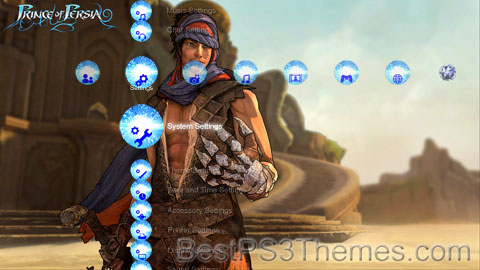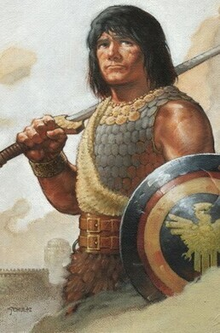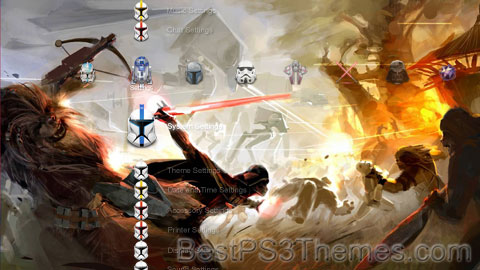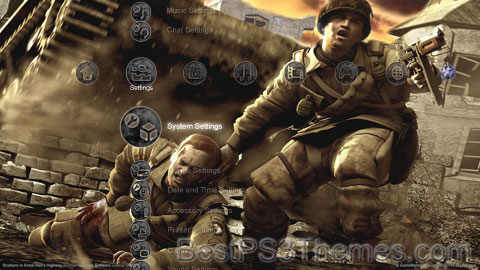Prince of Persia theme by OPTIMUS
Download: PrinceofPersia_2.p3t

(10 backgrounds)
Prince of Persia is a video game franchise created by Jordan Mechner. It is centered around a series of action-adventure games focused on various incarnations of the eponymous Prince, set in ancient and medieval Persia.
The first two games in the series, Prince of Persia (1989) and Prince of Persia 2: The Shadow and the Flame (1993), were published by Broderbund. Prince of Persia 3D (1999), named for being the first installment to use 3D computer graphics, was developed by Red Orb Entertainment and published by The Learning Company on PC; the Dreamcast version was developed by Avalanche Software and published by Mattel Interactive. Ubisoft bought the rights to the franchise in 2001 and rebooted it with Prince of Persia: The Sands of Time (2003). Ubisoft has since developed and published five additional entries in the series: Prince of Persia: Warrior Within (2004), Prince of Persia: The Two Thrones (2005), Prince of Persia (2008), Prince of Persia: The Forgotten Sands (2010), and Prince of Persia: The Lost Crown (2024), as well as a number of spin-offs and games for mobile devices.
Outside of the games, the franchise includes a film adaptation based on The Sands of Time, written in part by Mechner, and released by Walt Disney Pictures in 2010; a graphic novel; and the Lego Prince of Persia toyline. Ubisoft's Assassin's Creed franchise is considered to be the spiritual successor to the series.[1][2][3]
Games[edit]
| 1989 | Prince of Persia |
|---|---|
| 1990 | |
| 1991 | |
| 1992 | |
| 1993 | The Shadow and the Flame |
| 1994 | |
| 1995 | |
| 1996 | |
| 1997 | |
| 1998 | |
| 1999 | Prince of Persia 3D |
| 2000 | |
| 2001 | |
| 2002 | Prince of Persia: Harem Adventures |
| 2003 | The Sands of Time |
| 2004 | Warrior Within |
| 2005 | The Two Thrones |
| Battles of Prince of Persia | |
| 2006 | Prince of Persia Trilogy |
| 2007 | Prince of Persia Classic |
| 2008 | Prince of Persia |
| The Fallen King | |
| 2009 | |
| 2010 | The Forgotten Sands |
| The Forgotten Sands (Wii) | |
| The Forgotten Sands (Nintendo DS) | |
| The Forgotten Sands (PSP) | |
| 2011 | |
| 2012 | |
| 2013 | The Shadow and the Flame (remake) |
| 2014 | |
| 2015 | |
| 2016 | |
| 2017 | |
| 2018 | Prince of Persia: Escape |
| 2019 | |
| 2020 | |
| 2021 | |
| 2022 | Prince of Persia: Escape 2 |
| 2023 | |
| 2024 | Prince of Persia: The Lost Crown |
| The Rogue Prince of Persia (early access) | |
| 2025 | |
| 2026 | The Sands of Time (remake) |
| TBA | The Rogue Prince of Persia |
Original trilogy[edit]
The first game in the series was created by Jordan Mechner after the success of Karateka. Drawing from multiple general sources of inspiration, including the One Thousand and One Nights stories,[4] and films like Raiders of the Lost Ark[5] and The Adventures of Robin Hood,[6] the protagonist's character animation was created using a technique called rotoscoping, with Mechner using his brother as the model for the titular prince.[7] The original Prince of Persia, with its more than 20 platform ports, is one of the most ported games in video game history.[8][9]
Mechner enrolled in New York University's film department, producing an award-winning short film during his time there, before returning to design and direct a sequel to the original game.[10] The sequel, Prince of Persia 2: The Shadow and the Flame, was developed internally at Broderbund with Mechner's supervision. The game, like its predecessor, received critical acclaim and high sales. Broderbund was subsequently purchased by The Learning Company,[11] which was later acquired by US game company Mattel Interactive.[12] In 1999, Prince of Persia 3D was developed and released under Broderbund's Red Orb label.[10] Released for PC and the Dreamcast only,[13] it was criticized by many users as being buggy, and was a commercial disappointment.[10] The Broderbund/Learning Company's games division, the assets of which included the Prince of Persia franchise, was subsequently sold to Ubisoft.[14]
The Sands of Time series[edit]
Mechner, who owned the Prince of Persia intellectual property, was brought in to work with Ubisoft on a reboot of the franchise, titled The Sands of Time, although he was originally wary after the failure of Prince of Persia 3D.[15] The team they worked with was also working on Tom Clancy's Splinter Cell: their aim with the game was to "breathe new life into the action-adventure genre".[16][17]
Mechner did not take part in the production of the next game, Prince of Persia: Warrior Within, and he commented on finding the dark atmosphere and heightened level of violence unappealing.[18] The changes also provoked mixed reactions from critics, but sales were strong and a third game, eventually titled Prince of Persia: The Two Thrones, went into production.[19] For The Two Thrones, the developers and artists tried to strike a balance between the light, cartoon-like tones of The Sands of Time, and the grittier mediums of Warrior Within.[20]
A fourth installment in The Sands of Time series, Prince of Persia: The Forgotten Sands, was released in May 2010.[21] The Windows, Xbox 360 and PlayStation 3 versions of the game filled in some of the narrative gap between The Sands of Time and Warrior Within, whereas the PSP, Wii, and the DS versions each feature their own alternative storylines. The game was released as a tie in to The Sands of Time film adaptation.[22]
Trilogy collection[edit]
The Prince of Persia Trilogy (known as Prince of Persia Trilogy 3D on the remastered collection's title screen) is a collection of The Sands of Time trilogy released on the PlayStation 2 and subsequently on the PlayStation 3 as part of the Classics HD range.[23] The collection includes The Sands of Time, Warrior Within and The Two Thrones, all previously released on the PlayStation 2, Xbox and Microsoft Windows. The games were remastered in high-definition for the PlayStation 3 with 3D and PlayStation Network Trophy support on one Blu-ray Disc. The PlayStation 2 collection was released on October 27, 2006, in Europe,[citation needed] while the remastered collection was released on November 19, 2010, on Blu-ray in PAL regions. The release marks the first Classics HD title to not be published by Sony Computer Entertainment.
In North America, the three games were originally released separately as downloadable-only titles on the PlayStation Store. The first, The Sands of Time, was released on November 16, 2010, while the other two games followed in December.[24] The Blu-ray version was to be released in North America on March 22, 2011[25] but the collection ended up being delayed until April 19.
Prince of Persia 2008 reboot series[edit]
In 2006, concept designs surfaced hinting at another entry in the franchise.[26] The game, titled simply Prince of Persia, is a second reboot of the franchise, with its level and combat design harking back to the original 1989 game.[27] The game was released in December 2008, receiving positive reviews from most video game outlets and decent sales.[28] Alongside the main game, Ubisoft's Casablanca branch developed a direct sequel and spin-off for the Nintendo DS, titled Prince of Persia: The Fallen King,[29] which received fair reviews.[30][31][32][19]
Spin-offs and remakes[edit]
The first spin-off of the series was developed alongside and released in the same year as The Two Thrones for the Nintendo DS. Battles of Prince of Persia is a turn-based strategy game set between The Sands of Time and Warrior Within.[33] It received mediocre reviews from critics.[34][35]
In 2007, Gameloft and Ubisoft released Prince of Persia Classic, an enhanced remake of the original Prince of Persia for Java ME, Android, iOS, Xbox 360 (XBLA), and PlayStation 3 (PSN).[36] The visual style was upgraded to resemble Prince of Persia: The Sands of Time, and the Prince himself was given some additional moves, such as the ability to roll, backflip, wall jump and stop time briefly during combat. However, the core gameplay remains the same as the original – the player must defeat Jaffar within one hour while watching out for the many traps and defeating the guards they encounter.
There have been a number of mobile games for Java ME-based phones developed by Gameloft, some based on older PC or console titles with 2D graphics and others loosely based on contemporary games but with 2D graphics and different gameplay due to technology constraints. Gameloft has also developed some ports for both the iPhone and the iPad.[37] The first spin-off by Gameloft was titled Prince of Persia: Harem Adventures, released for Java phones in 2003.[38] Specifically, the company has developed HD remakes of the original Prince of Persia in 2007,[39] and its sequel The Shadow and the Flame in July 2013.[40][41]
In 2018, Ubisoft under the banner of its entity Ketchapp released Prince of Persia: Escape,[42] a mobile game for Android and iOS. It is a runner game made up of different levels,[43] and the player can customize the protagonist with outfits from past games. Reviewing for Pocket Gamer, Cameron Bald called Prince of Persia: Escape a "mundane game crushed under the weight of excessive greed".[44] In August 2022, a follow-up, Prince of Persia: Escape 2, was released.[45]
In January 2024, Ubisoft released the first major installment in the series since The Forgotten Sands, Prince of Persia: The Lost Crown. It is a 2.5D side-scrolling platformer and introduces a new storyline and protagonist, Sargon, a member of the Immortals.[46]
Future games[edit]
A remake of the Sands of Time, formally announced at Ubisoft Forward 2020, was originally scheduled for release on January 21, 2021, for Microsoft Windows, PlayStation 4 and Xbox One, but Ubisoft delayed the remake indefinitely.[47] In its quarterly financial report, Ubisoft stated that the remake was expected to be out sometime during its 2022–23 fiscal year.[48] The remake's development was moved to Ubisoft Montréal, a change from Ubisoft Mumbai and Ubisoft Pune. The company said the 2023 fiscal year release target was no longer being targeted.[49] A new release window of 2026 was announced at Ubisoft Forward 2024.[50]
The Rogue Prince of Persia is an upcoming 2.5D roguelike title developed by Evil Empire and set to release in Early Access on May 14, 2024. The game entered development around 2019, after a discussion between Evil Empire and Ubisoft at GDC, and its art direction is heavily inspired by Franco-Belgian comics. The game will be Ubisoft's first day-one Steam release in five years, as well as their first title to be released in Early Access before a full release.[51]
Canceled and unreleased games[edit]
Prince of Persia Redemption[edit]
In 2012, leaked images from a project entitled Osiris were assumed to be the next Prince of Persia title.[52] Jordan Mechner even commented on his Twitter account that the images were not from a Prince of Persia game.[53] A year later, Yannis Mallat, CEO of Ubisoft Montreal, said that the franchise was being "paused", saying that "as soon as we have something to show, we will".[54] In the following months, Ubisoft confirmed that it was either planning or considering next-generation entries in multiple franchises, including Prince of Persia.[55] A video uploaded by a Ubisoft Montreal artist in 2012 but only discovered in 2020 showed a gameplay trailer for Prince of Persia Redemption which would have been released for Windows, Xbox 360, and PlayStation 3.[56][57][58] According to Jonathan Cooper, a former Ubisoft animator at the time, the trailer was a mockup of the planned gameplay for the title created by Khai Nguyen, used to pitch the game concept. The game never developed beyond that point, though the work on the pitch trailer was used to prepare a similar trailer for Assassin's Creed III.[59]
Adaptations[edit]
Graphic novel[edit]
Jordan Mechner finished writing the story for a graphic novel in 2007. The novel was written by A.B. Sina, and illustrated by Alex Puvilland and LeUyen Pham. It was released by First Second Books in autumn 2008.[60][61] The story follows two Princes, jumping between the 9th and 13th centuries. Although it belongs to the franchise the plot is not related to any of the game continuities or that of the 2010 film.[62]
Film adaptation[edit]
In 2010, a film adaptation of The Sands of Time was released by Walt Disney Pictures. Starring Jake Gyllenhaal as Prince Dastan, it would go on to receive mixed reception, but still gross $336 million in theaters.[63] Besides The Sands of Time, the film also incorporated elements from Warrior Within and The Two Thrones, the two other titles from the Sands of Time trilogy of the Prince of Persia video game franchise.
Upon the film's release, it was accompanied by Before the Sandstorm, a 2010 one-shot comic book published by Disney Publishing Worldwide. This comic serves as both a direct prequel and sequel to the feature film, and explains the motives and backgrounds of some characters. It was written by Jordan Mechner and featured illustrations by Todd McFarlane, Niko Henrichon, David Lopez and Bernard Chang.
Lego Prince of Persia was released by The Lego Group in 2010, as part of the company's strategy to produce sets based on Disney properties.[64] Based on the feature film, Lego released six sets within the theme, as well as a short animated film, before discontinuing it.[65][66]
Reception[edit]
Awards[edit]
The success of the Prince of Persia series resulted in Guinness World Records awarding the series 6 world records in the Guinness World Records: Gamer's Edition 2008. These records include First Motion-Capture Animation in a Video Game and Highest Rated Platformer on PS2 and Xbox.
Impact and legacy[edit]
South Korean singer-songwriter Kim Kwang-Jin released the song 'Magic Castle', with lyrics inspired from the storyline of the original Prince of Persia.[67]
In 1992, Russian author Victor Pelevin wrote a book called A Werewolf Problem in Central Russia and Other Stories, in which there is a short story called "Prince of Gosplan". The story is greatly influenced by the game; the main hero of the story lives in a mixed reality of the real world and video games and identifies himself as Prince of Persia. He tries to understand if his life is real or if he is just seeing it on a computer display.[68]
The feel of the gameplay in Tomb Raider was intended to evoke that of the original Prince of Persia.[69]
The Assassin's Creed series originated out of ideas for a sequel for Prince of Persia: The Sands of Time. Its critical and financial success led Ubisoft to request Ubisoft Montreal to develop a sequel, aiming for the Xbox 360 and PlayStation 3. The Ubisoft Montreal team decided on taking the gameplay from The Sands of Time into an open world approach, taking advantage of the improved processing power to render larger spaces and crowds. Narratively, the team wanted to move away from the Prince being someone next in line for the throne but to have to work for it; combined with research into secret societies led them to focus on the Assassins, heavily borrowing from the novel Alamut.[70] They developed a narrative where the player would control an Assassin that served as a bodyguard for a non-playable Prince, leading them to call this game Prince of Persia: Assassin. The "Animus" device allowed them to explain certain facets of gameplay, such as accounting when the player fails a mission, in the same way they had done in The Sands of Time.[70]
References[edit]
- ^
Conan the Barbarian  Illustration of Conan by Mark Schultz
Illustration of Conan by Mark SchultzFirst appearance Weird Tales (December 1932) Created by Robert E. Howard Portrayed by - Arnold Schwarzenegger (1982 and 1984 films)
- Jorge Sanz
(1982 film, Young) - Ralf Möller
(Television series) - Jason Momoa
(2011 film) - Leo Howard
(2011 film, Young)
Voiced by - Michael Donovan
(Conan the Adventurer) - Phil Hayes
(Conan and the Young Warriors) - Ron Perlman
(Conan (2007 video game)) - Matthew Waterson
(Conan Exiles)
In-universe information Species Human Gender Male Occupation Current:
King
Former:
Adventurer
Pirate
Warrior
Slave
Gladiator
ThiefReligion Worship of Crom Origin Cimmeria, Hyboria Nationality Cimmerian Conan the Barbarian (also known as Conan the Cimmerian) is a fictional sword and sorcery hero who originated in pulp magazines and has since been adapted to books, comics, films (including Conan the Barbarian and Conan the Destroyer), television programs (animated and live-action), video games, and role-playing games. Robert E. Howard created the character in 1932 for a series of fantasy stories published in Weird Tales magazine.
The earliest appearance of a Robert E. Howard character named Conan was that of a black-haired barbarian with heroic attributes in the 1931 short story "People of the Dark". By 1932, Howard had fully conceptualized Conan. Before his death, Howard had written 21 stories starring the barbarian. Over the years many other writers have written works featuring Conan.
Many Conan the Barbarian stories feature Conan embarking on heroic adventures filled with common fantasy elements such as princesses and wizards. Howard's mythopoeia has the stories set in the legendary Hyborian Age in the times after the fall of Atlantis. Conan is a Cimmerian, who are descendants of the Atlanteans and ancestors of the modern Gaels. Conan is himself a descendant of Kull of Atlantis (an earlier adventurer of Howard's). He was born on a battlefield and is the son of a blacksmith. Conan is characterized as chivalric due to his penchant to save damsels in distress. He is honorable and has a sense of enduring loyalty. In contrast to his brooding ancestor, Kull, Conan has a sense of humour. He possesses great strength, combativeness, intelligence, agility, and endurance. The barbarian's appearance is iconic, with square-cut black hair, blue eyes, tanned skin, and giant stature, often wearing a barbarian's garb.
Licensed comics published in the 1970s by Marvel Comics drew further popularity to the character, introducing the now iconic image of Conan in his loincloth. The most popular cinematic adaptation is the 1982 film, Conan the Barbarian directed by John Milius and starring Arnold Schwarzenegger as Conan, in which the plot revolves around Conan facing the villainous Thulsa Doom.
Publication history[edit]
Robert E. Howard created Conan the Barbarian in a series of fantasy stories published in Weird Tales from 1932.[1] Howard was searching for a new character to market to the burgeoning pulp outlets of the early 1930s. In October 1931, he submitted the short story "People of the Dark" to Clayton Publications' new magazine, Strange Tales of Mystery and Terror (June 1932). "People of the Dark" is a story about the remembrance of "past lives", and in its first-person narrative, the protagonist describes one of his previous incarnations: Conan is a black-haired barbarian hero who swears by a deity called Crom. Some Howard scholars believe this Conan to be a forerunner of the more famous character.[2]
In February 1932, Howard vacationed at a border town on the lower Rio Grande. During this trip, he further conceived the character of Conan and also wrote the poem "Cimmeria", much of which echoes specific passages in Plutarch's Lives.[3][4] According to some scholars, reading Thomas Bulfinch inspired Howard to "coalesce into a coherent whole his literary aspirations and the strong physical, autobiographical elements underlying the creation of Conan".[2]
Having digested these influences upon returning from his trip, Howard rewrote a rejected story, "By This Axe I Rule!" (May 1929), replacing his existing character Kull of Atlantis with his new hero and re-titling it "The Phoenix on the Sword". Howard also wrote "The Scarlet Citadel" and "The Frost-Giant's Daughter", inspired by the Greek myth of Daphne,[citation needed] and submitted both stories to Weird Tales magazine. Although "The Frost-Giant's Daughter" was rejected, the magazine accepted "The Phoenix on the Sword" after it received the requested polishing, and published it in the December 1932 issue. "The Scarlet Citadel" was published the following month.[2]
"The Phoenix on the Sword" appeared in Weird Tales cover-dated December 1932. Editor Farnsworth Wright subsequently prompted Howard to write an 8,000-word essay for personal use detailing "the Hyborian Age", the fictional setting for Conan. Using this essay as his guideline, Howard began plotting "The Tower of the Elephant", a new Conan story that was the first to integrate his new conception of the Hyborian world.[2]
The publication and success of "The Tower of the Elephant" spurred Howard to write more Conan stories for Weird Tales. By the time of Howard's suicide in 1936, he had written 21 complete stories, 17 of which had been published, as well as multiple unfinished fragments.[2]
Following Howard's death, the copyright of the Conan stories passed through several hands. Eventually L. Sprague de Camp was entrusted with management of the fiction line and, beginning with 1967's Conan released by Lancer Books, oversaw a paperback series collecting all of Howard's stories (Lancer folded in 1973 and Ace Books picked up the line, reprinting the older volumes with new trade dress and continuing to release new ones). Howard's original stories received additional edits by de Camp, and de Camp also decided to create additional Conan stories to publish alongside the originals, working with Björn Nyberg and especially Lin Carter. These new stories were created from a mixture of already-complete Howard stories with different settings and characters that were altered to feature Conan and the Hyborian setting instead, incomplete fragments and outlines for Conan stories that were never completed by Howard, and all-new pastiches. Lastly, de Camp created prefaces for each story, fitting them into a timeline of Conan's life that he created.
For roughly 40 years, the original versions of Howard's Conan stories remained out of print. In 1977, the publisher Berkley Books issued three volumes using the earliest published form of the texts from Weird Tales and thus no de Camp edits, with Karl Edward Wagner as series editor, but these were halted by action from de Camp before the remaining three intended volumes could be released. In the 1980s and 1990s, the copyright holders permitted Howard's stories to go out of print entirely as the public demand for sword & sorcery dwindled, but continued to release the occasional new Conan novel by other authors such as Leonard Carpenter, Roland Green, and Harry Turtledove.[citation needed]
In 2000, the British publisher Gollancz Science Fiction issued a two-volume, complete edition of Howard's Conan stories as part of its Fantasy Masterworks imprint, which included several stories that had never seen print in their original form. The Gollancz edition mostly used the versions of the stories as published in Weird Tales.[5]
The two volumes were combined and the stories restored to chronological order as The Complete Chronicles of Conan: Centenary Edition (Gollancz Science Fiction, 2006; edited and with an Afterword by Steve Jones).
In 2003, another British publisher, Wandering Star Books,[6] made an effort both to restore Howard's original manuscripts and to provide a more scholarly and historical view of the Conan stories. It published hardcover editions in England, which were republished in the United States by the Del Rey imprint of Ballantine Books. The first book, Conan of Cimmeria: Volume One (1932–1933) (2003; published in the US as The Coming of Conan the Cimmerian) includes Howard's notes on his fictional setting as well as letters and poems concerning the genesis of his ideas. This was followed by Conan of Cimmeria: Volume Two (1934) (2004; published in the US as The Bloody Crown of Conan) and Conan of Cimmeria: Volume Three (1935–1936) (2005; published in the US as The Conquering Sword of Conan). These three volumes include all the original Conan stories.
Setting[edit]
The stories occur in the fictional "Hyborian Age", set after the destruction of Atlantis and before the rise of any historical ancient civilization. This is a specific epoch in a fictional timeline created by Howard for many of the low fantasy tales of his artificial legendary.[7]
Howard invented the Hyborian Age as a useful literary device. He had an intense love for history and historical dramas, but he also recognized the difficulties and the time-consuming research work needed in maintaining historical accuracy. Also, the poorly-stocked libraries in the rural part of Texas where Howard lived didn't have the material needed for such research. By conceiving a fictional "vanished age" and choosing names that resembled historical ones, Howard avoided anachronisms and the need for lengthy exposition.[2]
According to "The Phoenix on the Sword", the adventures of Conan take place "Between the years when the oceans drank Atlantis and the gleaming cities, and the years of the rise of the Sons of Aryas."[8]
Personality and character[edit]
Hither came Conan, the Cimmerian, black-haired, sullen-eyed, sword in hand, a thief, a reaver, a slayer, with gigantic melancholies and gigantic mirth, to tread the jeweled thrones of the Earth under his sandalled feet."
Conan is a Cimmerian. The writings of Robert E. Howard (particularly his essay "The Hyborian Age") suggests that his Cimmerians are based on the Celts or perhaps the historic Cimmerians. Conan was born on a battlefield and is the son of a village blacksmith. Conan matured quickly as a youth and, by age fifteen, he was already a respected warrior who had participated in the destruction of the Aquilonian fortress of Venarium.[9] After its demise, he was struck by wanderlust and began the adventures chronicled by Howard, encountering skulking monsters, evil wizards, tavern wenches, and beautiful princesses. He roamed throughout the Hyborian Age nations as a thief, outlaw, mercenary, and pirate.[10] As he grew older, he began commanding vast units of warriors and escalating his ambitions. In his forties, he seized the crown from the tyrannical king of Aquilonia, the most powerful kingdom of the Hyborian Age, having strangled the previous ruler on the steps of his own throne.[11] Conan's adventures often result in him performing heroic feats, though his motivation for doing so is largely to protect his own survival or for personal gain.
A conspicuous element of Conan's character is his chivalry. He is extremely reluctant to fight women (even when they fight him) and has a strong tendency to save a damsel in distress. In "Jewels of Gwahlur", he has to make a split-second decision whether to save the dancing girl Muriela or the chest of priceless gems which he spent months in search of. So, without hesitation, he rescues Muriela and allows for the treasure to be irrevocably lost. In "The Black Stranger", Conan saves the exile Zingaran Lady Belesa at considerable risk to himself, giving her as a parting gift his fortune in gems big enough to have a comfortable and wealthy life in Zingara, while asking for no favors in return. Reviewer Jennifer Bard also noted[12] that when Conan is in a pirate crew or a robber gang led by another male, his tendency is to subvert and undermine the leader's authority, and eventually supplant (and often, kill) him (e.g. "Pool of the Black One", "A Witch Shall be Born", "Shadows in the Moonlight"). Conversely, in "Queen of the Black Coast", it is noted that Conan "generally agreed to Belit's plan. Hers was the mind that directed their raids, his the arm that carried out her ideas. It was a good life." And at the end of "Red Nails", Conan and Valeria seem to be headed towards a reasonably amicable piratical partnership.
Appearance[edit]

Fan art of Conan the Barbarian in his iconic loincloth. Conan has "sullen", "smoldering", and "volcanic" blue eyes with a black "square-cut mane". Howard once describes him as having a hairy chest and, while comic book interpretations often portray Conan as wearing a loincloth or other minimalist clothing to give him a more barbaric image, Howard describes the character as wearing whatever garb is typical for the kingdom and culture in which Conan finds himself. Howard never gave a strict height or weight for Conan in a story, only describing him in loose terms like "giant" and "massive".[13] In the tales, no human is ever described as being stronger than Conan, although a few are mentioned as taller (including the strangler, Baal-Pteor) or of larger bulk. In a letter to P. Schuyler Miller and John D. Clark in 1936, only three months before Howard's death, Conan is described as standing 6 ft/183 cm and weighing 180 pounds (82 kg) when he takes part in an attack on Venarium at only 15 years old, though being far from fully grown. At one point, when he is meeting Juma in Kush, he describes Conan as tall as his friend, at nearly 7 ft. in height. Conan himself says in "Beyond the Black River" that he had "not yet seen 15 snows". at the Battle of Venarium. "At Vanarium he was already a formidable antagonist, though only fifteen, He stood six feet tall [1.83 m] and weighed 180 pounds [82 kg], though he lacked much of having his full growth." Although Conan is muscular, Howard frequently compares his agility and way of moving to that of a panther (see, for instance, "Jewels of Gwahlur", "Beyond the Black River", or "Rogues in the House"). His skin is frequently characterized as bronzed from constant exposure to the sun. In his younger years, he is often depicted wearing a light chain shirt and a horned helmet, though appearances vary with different stories.
During his reign as king of Aquilonia, Conan was[excessive quote]
[...] a tall man, mightily shouldered and deep of chest, with a massive corded neck and heavily muscled limbs. He was clad in silk and velvet, with the royal lions of Aquilonia worked in gold upon his rich jupon, and the crown of Aquilonia shone on his square-cut black mane; but the great sword at his side seemed more natural to him than the regal accoutrements. His brow was low and broad, his eyes a volcanic blue that smoldered as if with some inner fire. His dark, scarred, almost sinister face was that of a fighting-man, and his velvet garments could not conceal the hard, dangerous lines of his limbs.[14]
Howard imagined the Cimmerians as a pre-Celtic people with mostly black hair and blue or grey eyes. Ethnically, the Cimmerians to which Conan belongs are descendants of the Atlanteans, though they do not remember their ancestry. In his fictional historical essay "The Hyborian Age", Howard describes how the people of Atlantis—the land where his character King Kull originated—had to move east after a great cataclysm changed the face of the world and sank their island, settling where Ireland and Scotland would eventually be located. Thus they are (in Howard's work) the ancestors of the Irish and Scottish (the Celtic Gaels) and not the Picts, the other ancestor of modern Scots who also appear in Howard's work. In the same work, Howard also described how the Cimmerians eventually moved south and east after the age of Conan (presumably in the vicinity of the Black Sea, where the historical Cimmerians dwelt).
Abilities[edit]
Despite his brutish appearance, Conan uses his brains as well as his brawn. The Cimmerian is a highly skilled warrior, possibly without peer with a sword, but his travels have given him vast experience in other trades, especially as a thief. He's also a talented commander, tactician, and strategist, as well as a born leader. In addition, Conan has advanced knowledge of languages and codes and is able to recognize, or even decipher, certain ancient or secret signs and writings. For example, in "Jewels of Gwahlur" Howard states: "In his roaming about the world the giant adventurer had picked up a wide smattering of knowledge, particularly including the speaking and reading of many alien tongues. Many a sheltered scholar would have been astonished at the Cimmerian's linguistic abilities." He also has incredible stamina, enabling him to go without sleep for a few days. In "A Witch Shall be Born", Conan fights armed men until he is overwhelmed, captured, and crucified, before going an entire night and day without water. However, Conan still possesses the strength to pull the nails from his feet, while hoisting himself into a horse's saddle and riding for ten miles.
Another noticeable trait is his sense of humor, largely absent in the comics and movies, but very much a part of Howard's original vision of the character (particularly apparent in "Xuthal of the Dusk", also known as "The Slithering Shadow".) His sense of humor can also be rather grimly ironic, as was demonstrated by how he unleashes his own version of justice on the treacherous—and ill-fated—innkeeper Aram Baksh in "Shadows in Zamboula".
He is a loyal friend to those true to him, with a barbaric code of conduct that often marks him as more honorable than the more sophisticated people he meets in his travels. Indeed, his straightforward nature and barbarism are constants in all the tales.
Conan is a formidable combatant both armed and unarmed. With his back to the wall, Conan is capable of engaging and killing opponents by the score. This is seen in several stories, such as "Queen of the Black Coast", "The Scarlet Citadel", and "A Witch Shall Be Born". Conan is not superhuman, though; he needed the providential help of Zelata's wolf to defeat four Nemedian soldiers in Howard's novel The Hour of the Dragon. Some of his hardest victories have come from fighting single opponents of inhuman strength: one such as Thak, an ape-like humanoid from "Rogues in the House", or the strangler Baal-Pteor in "Shadows in Zamboula". Conan is far from untouchable and has been captured or defeated several times (on one occasion, knocking himself out after drunkenly running into a wall).
Influences[edit]
Howard frequently corresponded with H. P. Lovecraft, and the two would sometimes insert references or elements of each other's settings in their works. Later editors reworked many of the original Conan stories by Howard, thus diluting this connection. Nevertheless, many of Howard's unedited Conan stories are arguably part of the Cthulhu Mythos.[15] Additionally, many of the Conan stories by Howard, de Camp, and Carter used geographical place names from Clark Ashton Smith's Hyperborean Cycle.
Original Robert E. Howard Conan stories[edit]

Cover of Weird Tales (May 1934) depicting Conan and Bêlit in "Queen of the Black Coast", one of Robert E. Howard's original Conan stories Conan stories published in Weird Tales[edit]
- "The Phoenix on the Sword" (novelette; vol. 20, #6, December 1932)
- "The Scarlet Citadel" (novelette; vol. 21, #1, January 1, 1933)
- "The Tower of the Elephant" (novelette; vol. 21, #3, March 1933)
- "Black Colossus" (novelette; vol. 21, #6, June 1933)
- "The Slithering Shadow" (novelette; vol. 22, #3, September 1933, alternate title "Xuthal of the Dusk")
- "The Pool of the Black One" (novelette; vol. 22, #4, October 1933)
- "Rogues in the House" (novelette; vol. 23, #1, January 1934)
- "Iron Shadows in the Moon" (novelette; vol. 23, #4, April 1934, published as "Shadows in the Moonlight")
- "Queen of the Black Coast" (novelette; vol. 23, #5, May 1934)
- "The Devil in Iron" (novelette; vol. 24, #2, August 1934)
- "The People of the Black Circle" (novella; vol. 24, #3–5, September–November 1934)
- "A Witch Shall Be Born" (novelette; vol. 24, #6, December 1934)
- "Jewels of Gwahlur" (novelette; vol. 25, #3, March 1935, author's original title "The Servants of Bit-Yakin")
- "Beyond the Black River" (novella; vol. 25, #5–6, May–June 1935)
- "Shadows in Zamboula" (novelette; vol. 26, #5, November 1935, author's original title "The Man-Eaters of Zamboula")
- "The Hour of the Dragon" (novel; vol. 26, #6 & vol. 27, #1–4, December 1935, January–April 1936)
- "Red Nails" (novella; vol. 28, #1–3, July, September, October 1936)
Conan stories published in Fantasy Fan magazine[edit]
- "Gods of the North" (March 1934) – published as The Frost-Giant's Daughter in The Coming of Conan, 1953.[16]
Conan stories not published in Howard's lifetime[edit]
- "The God in the Bowl" – Published in Space Science Fiction, Sep. 1952.
- "The Black Stranger" – Published in Fantasy Magazine, Feb. 1953.
- "The Vale of Lost Women" – Published in The Magazine of Horror, Spring 1967.
Unfinished Conan stories by Howard[edit]
- "The Drums of Tombalku" – Fragment. Published in Conan the Adventurer, 1966.
- "The Hall of the Dead" – Synopsis. Published in The Magazine of Fantasy and Science Fiction, February 1967.
- "The Hand of Nergal" – Fragment. Published in Conan, 1967.
- "The Snout in the Dark" – Fragment. Published in Conan of Cimmeria, 1969.
A number of untitled synopses for Conan stories also exist.
[edit]
- "Wolves Beyond the Border" – A non-Conan story set in Conan's world. Fragment. Published in 1967 in Conan the Usurper
- "The Hyborian Age" – An essay written in 1932. Published in 1938 in The Hyborian Age.
- "Cimmeria" – A poem written in 1932. Published in 1965 in The Howard Collector.
Book editions[edit]
The character of Conan has proven durably popular, resulting in Conan stories by later writers such as Poul Anderson, Leonard Carpenter, Lin Carter, L. Sprague de Camp, Roland J. Green, John C. Hocking, Robert Jordan, Sean A. Moore, Björn Nyberg, Andrew J. Offutt, Steve Perry, John Maddox Roberts, Harry Turtledove, and Karl Edward Wagner. Some of these writers have finished incomplete Conan manuscripts by Howard. Others were created by rewriting Howard stories which originally featured entirely different characters from entirely different milieus. Most, however, are completely original works. In total, more than fifty novels and dozens of short stories featuring the Conan character have been written by authors other than Howard.
The Gnome Press edition (1950–1957) was the first hardcover collection of Howard's Conan stories, including all the original Howard material known to exist at the time, some left unpublished in his lifetime. The later volumes contain some stories rewritten by L. Sprague de Camp (like "The Treasure of Tranicos"), including several non-Conan Howard stories, mostly historical exotica situated in the Levant at the time of the Crusades, which he turned into Conan yarns. The Gnome edition also issued the first Conan story written by an author other than Howard—the final volume published, which is by Björn Nyberg and revised by de Camp.
The Lancer/Ace editions (1966–1977), under the direction of de Camp and Lin Carter, were the first comprehensive paperbacks, compiling the material from the Gnome Press series together in a chronological order with all the remaining original Howard material, including that left unpublished in his lifetime and fragments and outlines. These were completed by de Camp and Carter. The series also included Howard stories originally featuring other protagonists that were rewritten by de Camp as Conan stories. New Conan stories written entirely by de Camp and Carter were added as well. Lancer Books went out of business before bringing out the entire series, the publication of which was completed by Ace Books. Eight of the eventual twelve volumes published featured dynamic cover paintings by Frank Frazetta that, for many fans,[who?] presented the definitive, iconic impression of Conan and his world. For decades to come, most other portrayals of the Cimmerian and his imitators were heavily influenced by the cover paintings of this series.[
Dark Side: The Force Unleashed
Dark Side: The Force Unleashed theme by YASAI
Download: DarkSideTheForceUnleashed.p3t

(3 backgrounds)
P3T Unpacker v0.12
Copyright (c) 2007. Anoop Menon
This program unpacks Playstation 3 Theme files (.p3t) so that you can touch-up an existing theme to your likings or use a certain wallpaper from it (as many themes have multiple). But remember, if you use content from another theme and release it, be sure to give credit!
Download for Windows: p3textractor.zip
Instructions:
Download p3textractor.zip from above. Extract the files to a folder with a program such as WinZip or WinRAR. Now there are multiple ways to extract the theme.
The first way is to simply open the p3t file with p3textractor.exe. If you don’t know how to do this, right click the p3t file and select Open With. Alternatively, open the p3t file and it will ask you to select a program to open with. Click Browse and find p3textractor.exe from where you previously extracted it to. It will open CMD and extract the theme to extracted.[filename]. After that, all you need to do for any future p3t files is open them and it will extract.
The second way is very simple. Just drag the p3t file to p3textractor.exe. It will open CMD and extract the theme to extracted.[filename].
For the third way, first put the p3t file you want to extract into the same folder as p3textractor.exe. Open CMD and browse to the folder with p3extractor.exe. Enter the following:
p3textractor filename.p3t [destination path]Replace filename with the name of the p3t file, and replace [destination path] with the name of the folder you want the files to be extracted to. A destination path is not required. By default it will extract to extracted.filename.
Contemporary
The Tobasco Brand
The Tobasco Brand theme by ZHero
Download: TobascoBrand.p3t

(9 backgrounds)
P3T Unpacker v0.12
Copyright (c) 2007. Anoop Menon
This program unpacks Playstation 3 Theme files (.p3t) so that you can touch-up an existing theme to your likings or use a certain wallpaper from it (as many themes have multiple). But remember, if you use content from another theme and release it, be sure to give credit!
Download for Windows: p3textractor.zip
Instructions:
Download p3textractor.zip from above. Extract the files to a folder with a program such as WinZip or WinRAR. Now there are multiple ways to extract the theme.
The first way is to simply open the p3t file with p3textractor.exe. If you don’t know how to do this, right click the p3t file and select Open With. Alternatively, open the p3t file and it will ask you to select a program to open with. Click Browse and find p3textractor.exe from where you previously extracted it to. It will open CMD and extract the theme to extracted.[filename]. After that, all you need to do for any future p3t files is open them and it will extract.
The second way is very simple. Just drag the p3t file to p3textractor.exe. It will open CMD and extract the theme to extracted.[filename].
For the third way, first put the p3t file you want to extract into the same folder as p3textractor.exe. Open CMD and browse to the folder with p3extractor.exe. Enter the following:
p3textractor filename.p3t [destination path]Replace filename with the name of the p3t file, and replace [destination path] with the name of the folder you want the files to be extracted to. A destination path is not required. By default it will extract to extracted.filename.
Spectrum
Spectrum theme by Quagmire
Download: Spectrum.p3t

(4 backgrounds)

A spectrum (pl.: spectra or spectrums)[1] is a condition that is not limited to a specific set of values but can vary, without gaps, across a continuum. The word spectrum was first used scientifically in optics to describe the rainbow of colors in visible light after passing through a prism. As scientific understanding of light advanced, it came to apply to the entire electromagnetic spectrum. It thereby became a mapping of a range of magnitudes (wavelengths) to a range of qualities, which are the perceived "colors of the rainbow" and other properties which correspond to wavelengths that lie outside of the visible light spectrum.
Spectrum has since been applied by analogy to topics outside optics. Thus, one might talk about the "spectrum of political opinion", or the "spectrum of activity" of a drug, or the "autism spectrum". In these uses, values within a spectrum may not be associated with precisely quantifiable numbers or definitions. Such uses imply a broad range of conditions or behaviors grouped together and studied under a single title for ease of discussion. Nonscientific uses of the term spectrum are sometimes misleading. For instance, a single left–right spectrum of political opinion does not capture the full range of people's political beliefs. Political scientists use a variety of biaxial and multiaxial systems to more accurately characterize political opinion.
In most modern usages of spectrum there is a unifying theme between the extremes at either end. This was not always true in older usage.
Etymology[edit]
In Latin, spectrum means "image" or "apparition", including the meaning "spectre". Spectral evidence is testimony about what was done by spectres of persons not present physically, or hearsay evidence about what ghosts or apparitions of Satan said. It was used to convict a number of persons of witchcraft at Salem, Massachusetts in the late 17th century. The word "spectrum" [Spektrum] was strictly used to designate a ghostly optical afterimage by Goethe in his Theory of Colors and Schopenhauer in On Vision and Colors.
The prefix "spectro-" is used to form words relating to spectra. For example, a spectrometer is a device used to record spectra and spectroscopy is the use of a spectrometer for chemical analysis.
Physical sciences[edit]

In the physical sciences, the term spectrum was introduced first into optics by Isaac Newton in the 17th century, referring to the range of colors observed when white light was dispersed through a prism.[2][3] Soon the term referred to a plot of light intensity or power as a function of frequency or wavelength, also known as a spectral density plot.
Later it expanded to apply to other waves, such as sound waves and sea waves that could also be measured as a function of frequency (e.g., noise spectrum, sea wave spectrum). It has also been expanded to more abstract "signals", whose power spectrum can be analyzed and processed. The term now applies to any signal that can be measured or decomposed along a continuous variable, such as energy in electron spectroscopy or mass-to-charge ratio in mass spectrometry. Spectrum is also used to refer to a graphical representation of the signal as a function of the dependent variable.Biological science[edit]
Antibiotic spectrum of activity is a component of antibiotic classification. A broad-spectrum antibiotic is active against a wide range of bacteria,[4] whereas a narrow-spectrum antibiotic is effective against specific families of bacteria.[5] An example of a commonly used broad-spectrum antibiotic is ampicillin.[5] An example of a narrow spectrum antibiotic is Dicloxacillin, which acts on beta-lactamase-producing Gram-positive bacteria such as Staphylococcus aureus.[6]
In psychiatry, the spectrum approach uses the term spectrum to describe a range of linked conditions, sometimes also extending to include singular symptoms and traits. For example, the autism spectrum describes a range of conditions classified as neurodevelopmental disorders.
Mathematics[edit]
In mathematics, the spectrum of a matrix is the multiset of the eigenvalues of the matrix.
In functional analysis, the concept of the spectrum of a bounded operator is a generalization of the eigenvalue concept for matrices.
In algebraic topology, a spectrum is an object representing a generalized cohomology theory.
Social science[edit]

In social science, economic spectrum is used to indicate the range of social class along some indicator of wealth or income. In political science, the term political spectrum refers to a system of classifying political positions in one or more dimensions, for example in a range including right wing and left wing.
References[edit]
- ^ Dictionary.com Archived February 23, 2008, at the Wayback Machine. The American Heritage Dictionary of the English Language, Fourth Edition. Houghton Mifflin Company, 2004. (accessed: January 25, 2008).
- ^
 OpenStax Astronomy, "Spectroscopy in Astronomy". OpenStax CNX. September 29, 2016 "OpenStax CNX". Archived from the original on February 17, 2017. Retrieved February 17, 2017.
OpenStax Astronomy, "Spectroscopy in Astronomy". OpenStax CNX. September 29, 2016 "OpenStax CNX". Archived from the original on February 17, 2017. Retrieved February 17, 2017.
- ^ Newton, Isaac (1671). "A letter of Mr. Isaac Newton … containing his new theory about light and colours …". Philosophical Transactions of the Royal Society of London. 6 (80): 3075–3087. Bibcode:1671RSPT....6.3075N. doi:10.1098/rstl.1671.0072. The word "spectrum" to describe a band of colors that has been produced, by refraction or diffraction, from a beam of light first appears on p. 3076.
- ^ Taber, Clarence Wilbur (1993). Thomas, Clayton L. (ed.). Taber's cyclopedic medical dictionary (Ed. 17, illustrated, 3. print ed.). Philadelphia: F. A. Davis. ISBN 978-0-8036-8313-6.
- ^ a b S.J. Hopkins, Drugs and Pharmacology for Nurses 12th ed., 1997 (ISBN 0-443-05249 2)
- ^ Miranda-Novales G, Leaños-Miranda BE, Vilchis-Pérez M, Solórzano-Santos F (2006). "In vitro activity effects of combinations of cephalothin, dicloxacillin, imipenem, vancomycin and amikacin against methicillin-resistant Staphylococcus spp. strains". Ann. Clin. Microbiol. Antimicrob. 5: 25. doi:10.1186/1476-0711-5-25. PMC 1617116. PMID 17034644.
Specblue
Specblue theme by Quagmire
Download: Specblue.p3t

(4 backgrounds)
P3T Unpacker v0.12
Copyright (c) 2007. Anoop Menon
This program unpacks Playstation 3 Theme files (.p3t) so that you can touch-up an existing theme to your likings or use a certain wallpaper from it (as many themes have multiple). But remember, if you use content from another theme and release it, be sure to give credit!
Download for Windows: p3textractor.zip
Instructions:
Download p3textractor.zip from above. Extract the files to a folder with a program such as WinZip or WinRAR. Now there are multiple ways to extract the theme.
The first way is to simply open the p3t file with p3textractor.exe. If you don’t know how to do this, right click the p3t file and select Open With. Alternatively, open the p3t file and it will ask you to select a program to open with. Click Browse and find p3textractor.exe from where you previously extracted it to. It will open CMD and extract the theme to extracted.[filename]. After that, all you need to do for any future p3t files is open them and it will extract.
The second way is very simple. Just drag the p3t file to p3textractor.exe. It will open CMD and extract the theme to extracted.[filename].
For the third way, first put the p3t file you want to extract into the same folder as p3textractor.exe. Open CMD and browse to the folder with p3extractor.exe. Enter the following:
p3textractor filename.p3t [destination path]Replace filename with the name of the p3t file, and replace [destination path] with the name of the folder you want the files to be extracted to. A destination path is not required. By default it will extract to extracted.filename.
Keep It Organised (HD)
Keep It Organised (HD) theme by a.k.a.BATTOUSAI
Download: KeepItOrganised.p3t

(3 backgrounds, HD only)
P3T Unpacker v0.12
Copyright (c) 2007. Anoop Menon
This program unpacks Playstation 3 Theme files (.p3t) so that you can touch-up an existing theme to your likings or use a certain wallpaper from it (as many themes have multiple). But remember, if you use content from another theme and release it, be sure to give credit!
Download for Windows: p3textractor.zip
Instructions:
Download p3textractor.zip from above. Extract the files to a folder with a program such as WinZip or WinRAR. Now there are multiple ways to extract the theme.
The first way is to simply open the p3t file with p3textractor.exe. If you don’t know how to do this, right click the p3t file and select Open With. Alternatively, open the p3t file and it will ask you to select a program to open with. Click Browse and find p3textractor.exe from where you previously extracted it to. It will open CMD and extract the theme to extracted.[filename]. After that, all you need to do for any future p3t files is open them and it will extract.
The second way is very simple. Just drag the p3t file to p3textractor.exe. It will open CMD and extract the theme to extracted.[filename].
For the third way, first put the p3t file you want to extract into the same folder as p3textractor.exe. Open CMD and browse to the folder with p3extractor.exe. Enter the following:
p3textractor filename.p3t [destination path]Replace filename with the name of the p3t file, and replace [destination path] with the name of the folder you want the files to be extracted to. A destination path is not required. By default it will extract to extracted.filename.
Brothers in Arms: Hell’s Highway
Brothers in Arms: Hell’s Highway theme by Captainshaun
Download: BrothersinArmsHH.p3t

(3 backgrounds)
P3T Unpacker v0.12
Copyright (c) 2007. Anoop Menon
This program unpacks Playstation 3 Theme files (.p3t) so that you can touch-up an existing theme to your likings or use a certain wallpaper from it (as many themes have multiple). But remember, if you use content from another theme and release it, be sure to give credit!
Download for Windows: p3textractor.zip
Instructions:
Download p3textractor.zip from above. Extract the files to a folder with a program such as WinZip or WinRAR. Now there are multiple ways to extract the theme.
The first way is to simply open the p3t file with p3textractor.exe. If you don’t know how to do this, right click the p3t file and select Open With. Alternatively, open the p3t file and it will ask you to select a program to open with. Click Browse and find p3textractor.exe from where you previously extracted it to. It will open CMD and extract the theme to extracted.[filename]. After that, all you need to do for any future p3t files is open them and it will extract.
The second way is very simple. Just drag the p3t file to p3textractor.exe. It will open CMD and extract the theme to extracted.[filename].
For the third way, first put the p3t file you want to extract into the same folder as p3textractor.exe. Open CMD and browse to the folder with p3extractor.exe. Enter the following:
p3textractor filename.p3t [destination path]Replace filename with the name of the p3t file, and replace [destination path] with the name of the folder you want the files to be extracted to. A destination path is not required. By default it will extract to extracted.filename.
Glossy Icons v3
Glossy Icons v3 theme by DeathStepper
Download: GlossyIconsv3.p3t
![]()
(3 backgrounds)
P3T Unpacker v0.12
Copyright (c) 2007. Anoop Menon
This program unpacks Playstation 3 Theme files (.p3t) so that you can touch-up an existing theme to your likings or use a certain wallpaper from it (as many themes have multiple). But remember, if you use content from another theme and release it, be sure to give credit!
Download for Windows: p3textractor.zip
Instructions:
Download p3textractor.zip from above. Extract the files to a folder with a program such as WinZip or WinRAR. Now there are multiple ways to extract the theme.
The first way is to simply open the p3t file with p3textractor.exe. If you don’t know how to do this, right click the p3t file and select Open With. Alternatively, open the p3t file and it will ask you to select a program to open with. Click Browse and find p3textractor.exe from where you previously extracted it to. It will open CMD and extract the theme to extracted.[filename]. After that, all you need to do for any future p3t files is open them and it will extract.
The second way is very simple. Just drag the p3t file to p3textractor.exe. It will open CMD and extract the theme to extracted.[filename].
For the third way, first put the p3t file you want to extract into the same folder as p3textractor.exe. Open CMD and browse to the folder with p3extractor.exe. Enter the following:
p3textractor filename.p3t [destination path]Replace filename with the name of the p3t file, and replace [destination path] with the name of the folder you want the files to be extracted to. A destination path is not required. By default it will extract to extracted.filename.





